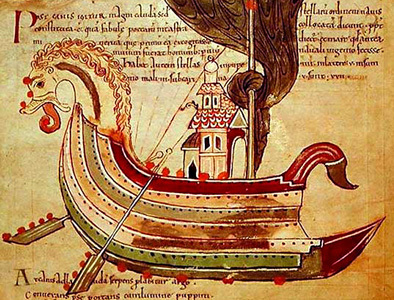The Vikings in Brittany Part 2
By 847 C.E. it became clear that the Viking invaders of Western Europe had developed political ambitions beyond the sporadic raiding of the previous three decades. Their sights moved beyond Britain and Normandy to other, less defended lands such as Ireland and Brittany. At first, resistance was effective. For example, within one year the Irish won an unprecedented four victories over the Vikings which effectively expelled a tremendous portion of the invaders from Ireland. But That same year in Brittany, Viking raiders began an invasion of the mainland peninsula and won three decisive victories over the Bretons who at the same time were repelling an invasion from the Franks. The Vikings used Noirmoutier, an island in the Bay of Biscay, as their base to launch a massive invasion attempt and to supply the warriors involved. The resources of the island, salt, was a necessary resource for any army of the time, and the Vikings were no exception.
With great cunning and strategic thinking, the Vikings exploited the rift along the Breton March between the Franks and the Bretons. A struggling Breton army even solicited the help of the Vikings to help defeat the Frankish army on two separate occasions. Once defeated, the Franks could no longer defend their borders, and the Viking invasion quickly saw the sack and occupation of Nantes on the Loire. With Nantes under Scandinavian control, the great citadels of Brittany followed: Cornouaille, Broweroch, Poutrocoët, Domnoée, and finally Saint-Brieuc. Pitting the two sides against one another, the Vikings expertly divided the lands and conquered them. By 854 C.E. a state of full military occupation was in place. So it seemed, Brittany would remain under their dominion.
Vikings, however, were ambitious people. No two groups thought alike, and no two groups settled for sharing power. In Normandy, the heavy influence and frequent raids of Vikings changed the political landscape. Charles the Bald, king of France, began a campaign to use the variable alliances of the Vikings against them. On the Seine, Charles hired Vikings to defend certain areas of the river. Once secured, Charles turned his attention to Brittany where a powerful warlord, Salomon, ruled over a large area of the region. At first, Salomon appeared keen on an alliance with Charles; the Vikings in the Loire themselves had recently been troubled by raids from other groups. Charles offered Salomon land rights and the status of vassal. Unfortunately for Salomon, a simultaneous Danish raid on Chartres and Tours following the new alliance sent the counts of Neustria (Western France) into revolt. Charles was forced to cancel his promises to Salomon.
Free of the protectorship of Charles the Bald, the Vikings on the Loire suffered a heavy defeat by Robert the Strong, the leading Neustrian Count who had had enough of the Scandinavians invading his lands. The conflict ended in a stalemate. For the next 20 years a similar political and military climate dominated the region. Along the Seine the Vikings continued to sack and pillage, and the Franks continued to rebuild and attempt to mount a resistance. Along the Loire, things settled. It had more or less been decided that Brittany had been lost to the invaders.
As luck would have it for the Bretons, Salomon was murdered by his rival in 874. The ensuing power vacuum caused a civil war between the Vikings in which a Breton-Frankish alliance emerged to drive an even deeper wound into the heart of the occupiers. Hope glimmered a moment, until the realization that the power vacuum left by Salomon would attract more raiders with ambitions of their own. The raids intensified. An internal struggle again erupted between the Bretons and the Franks, causing the resistance to dissolve. Sole one leader remained with a guerrilla force to fight the Vikings: a man named Alain of Broweroch. Alain mounted an effective resistance and pestered the invaders constantly. His big break came when the Carolingians successfully pushed out the Seine Vikings who fled into Brittany and disrupted the power structure there. With a renewed civil war between the Vikings, Alain fielded two Breton armies and led them to repeated victories. By 892 Alain had completely expelled the Vikings from Brittany. Scandinavian fortunes were not good along the Seine either: the Great Danish Army left mainland Europe and sailed for England to focus on the kingdom of Wessex.
Alain the Great ruled over Brittany after the expulsion of the Vikings as a sovereign king not loyal to Charles the Bald. The Bretons saw the Franks as incapable of defending them, and thus loyalty to the empire served them no benefit. A period of peace ensued. Through military endeavor, judicious alliances, and payment of Tribute, Alain kept the peace in his lands. Upon his death in 907 C.E., his successor, Gurmhailon should have had no trouble keeping this peace. The system put in place by Gurmhailon’s predecessor quickly fell to pieces. Scandinavian invaders again sacked the Breton coast and began deep incursions into Breton lands. In this chaos, one man would emerge to put an end to this long struggle. One man would rise to become the first true and remembered Duke of Brittany.






